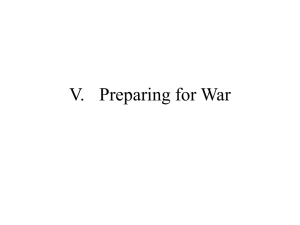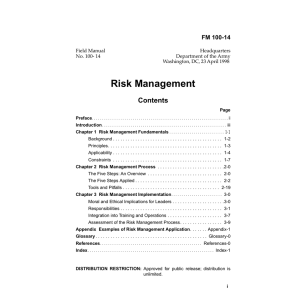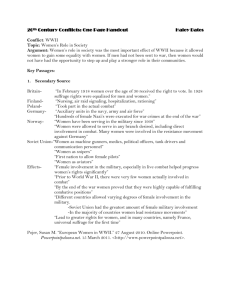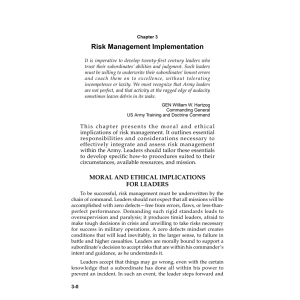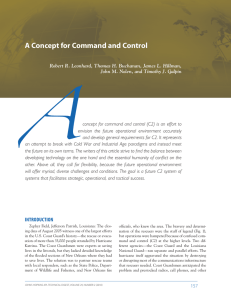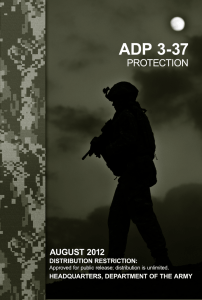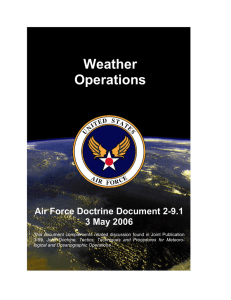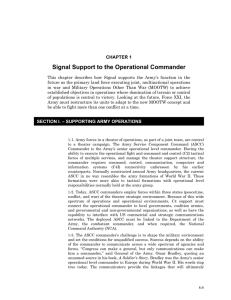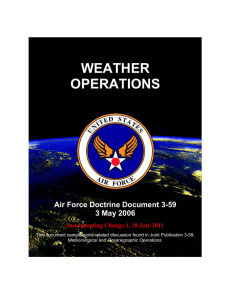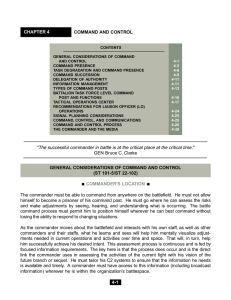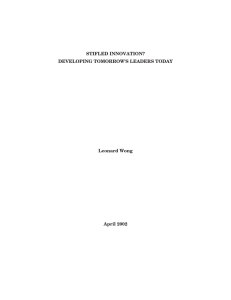Risk Management Fundamentals
advertisement
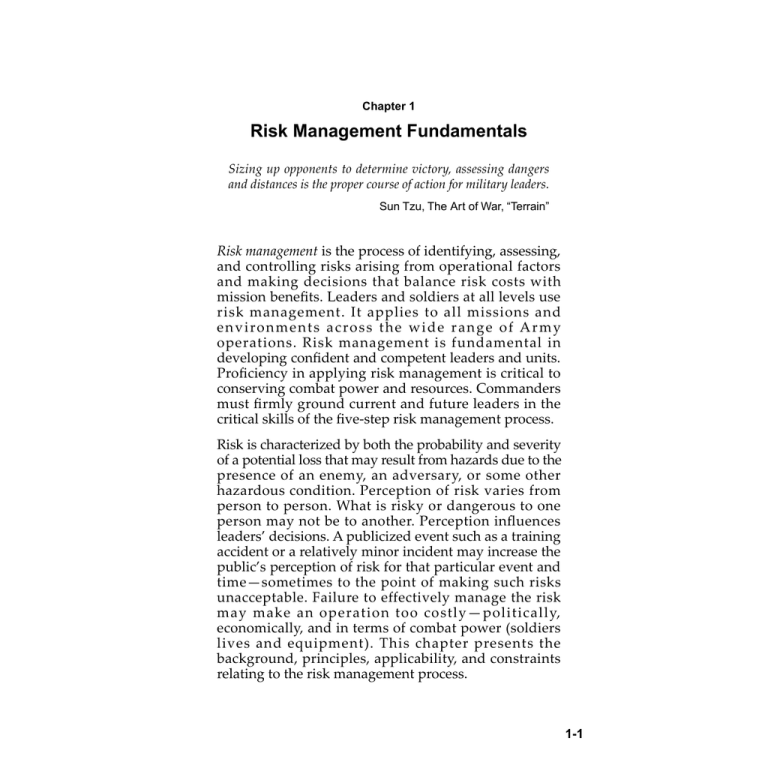
Chapter 1 Risk Management Fundamentals Sizing up opponents to determine victory, assessing dangers and distances is the proper course of action for military leaders. Sun Tzu, The Art of War, “Terrain” Risk management is the process of identifying, assessing, and controlling risks arising from operational factors and making decisions that balance risk costs with mission benefits. Leaders and soldiers at all levels use risk management. It applies to all missions and e n v i ro n m e n t s a c ro s s t h e w i d e r a n g e o f A r m y operations. Risk management is fundamental in developing confident and competent leaders and units. Proficiency in applying risk management is critical to conserving combat power and resources. Commanders must firmly ground current and future leaders in the critical skills of the five-step risk management process. Risk is characterized by both the probability and severity of a potential loss that may result from hazards due to the presence of an enemy, an adversary, or some other hazardous condition. Perception of risk varies from person to person. What is risky or dangerous to one person may not be to another. Perception influences leaders’ decisions. A publicized event such as a training accident or a relatively minor incident may increase the public’s perception of risk for that particular event and time—sometimes to the point of making such risks unacceptable. Failure to effectively manage the risk may make an operation too costly—politically, economically, and in terms of combat power (soldiers lives and equipment). This chapter presents the background, principles, applicability, and constraints relating to the risk management process. 1-1 Risk Management BACKGROUND Throughout the history of armed conflict, government and military leaders have tried to reckon with the effect of casualties on policy, strategy, and mission accomplishment. Government and military leaders consider battle losses from different perspectives. However, both must balance the following against the value of national objectives: • • • • • Effects of casualties. Impact on civilians. Damage to the environment. Loss of equipment. Level of public reaction. War is inherently complex, dynamic, and fluid. It is characterized by uncertainty, ambiguity, and friction. Uncertainty results from unknowns or lack of information. Ambiguity is the blurring or fog that makes it difficult to distinguish fact from impression about a situation and the enemy. Friction results from change, operational hazards, fatigue, and fears brought on by danger. These characteristics cloud the operating environment; they create risks that affect an army’s ability to fight and win. In uncertainty, ambiguity, and friction, both danger and opportunity exist. Hence, a leader’s ability to adapt and take risks are key traits. Chapter 2 of FM 100-5 provides information on the challenging circumstances of military operations during conflict. Historically, the Army has had more accidental losses, including fratricide (friendly fire), than losses from enemy action. See Figure 1-1. These accidental losses are the same types experienced in peacetime Army Accidents World War II Korea Vietnam Desert Shield/ Storm1 1942–1945 1950–1953 1965–1972 1990–1991 56% 44% 54% 75% Friendly Fire 1% 1% 1% 5% Enemy Action 43% 55% 45% 20% 1 These numbers include the relatively long buildup time and short period of combat action Figure 1-1. Battle and Nonbattle Casualties 1-2 FM 100-14 during training exercises. These losses are not caused by the enemy or an adversary. Factors include— • An ever-changing operational environment. • Effects of a fast-paced, high-operational tempo (OPTEMPO) and a high-personnel tempo (PERSTEMPO) on unit and human performance. Examples include leader or soldier error or failure to train or perform to standards. • Equipment failure, support failure, and the effects of the physical environment. PRINCIPLES The basic principles that provide a framework for implementing the risk management process are— • Integrating risk management into mission planning, preparation, and execution. Leaders and staffs continuously identify hazards and assess both accident and tactical risks. They then develop and coordinate control measures. They determine the level of residual risk for accident hazards in order to evaluate courses of action (COAs). They integrate control measures into staff estimates, operation plans (OPLANs), operation orders (OPORDs), and missions. Commanders assess the areas in which they might take tactical risks. They approve control measures that will reduce risks. Leaders ensure that all soldiers understand and properly execute risk controls. They continuously assess variable hazards and implement risk controls. • Making risk decisions at the appropriate level in the chain of command. The commander should address risk guidance in his commander ’s guidance. He bases his risk guidance on established Army and other appropriate policies and on his higher commander’s direction. He then gives guidance on how much risk he is willing to accept and delegate. Subordinates seek the higher commander’s approval to accept risks that might imperil the next higher commander’s intent. • Accepting no unnecessary risk. Commanders compare and balance risks against mission expectations and accept risks only if the benefits outweigh the potential costs or losses. Commanders alone decide whether to accept the level of residual risk to accomplish the mission. 1-3 Risk Management APPLICABILITY Risk management applies to all situations and environments across the wide range of Army operations, activities, and processes. Risk management is useful in developing, fielding, and employing the total Army force. Figure 1-2 summarizes the key aspects of risk management. DEVELOPMENT Development concerns include force design, manpower allocation, training and training developments, and combat and materiel developments (equipment and weapons systems) and battle laboratories. Risk management assists the commander or leader in— • Conserving lives and resources and avoiding unnecessary risk. • Making an informed decision to implement a COA. • Identifying feasible and effective control measures where specific standards do not exist. • Providing reasonable alternatives for mission accomplishment. Risk management does not— • Inhibit the commander’s and leader's flexibility and initiative. • Remove risk altogether, or support a zero defects mindset. • Require a GO/NO-GO decision. • Sanction or justify violating the law. • Remove the necessity for standard drills, tactics, techniques, and procedures. Figure 1-2. Key Aspects of Risk Management 1-4 FM 100-14 Force Design Concerns include risks introduced in trade-off decisions that involve the design and equipping of— • Tables of organization and equipment (TOE). • Modification tables of organization and equipment (MTOE). • Tables of distribution and allowances (TDA) organizations. Manpower Allocations Concerns include shortfalls in manning that put unit readiness and full use of combat system capabilities at risk. Training and Training Developments Concerns include hazardous and critical training tasks and feasible risk reduction measures that provide leaders with the flexibility to safely conduct tough, realistic training. Combat and Materiel Developments and Battle Laboratories Concerns include providing a means to assist in making informed trade-off decisions such as— • Balancing equipment form, fit, and function. • Balancing the durability and cost of equipment and spare parts against their reliability, availability, and maintainability requirements. • Determining the environmental impact. • Determining whether to accept systems with less than the full capabilities prescribed in requirement documents and experimental procedures. ARs 70-1 and 385-16 and MIL-STD-882 provide details on risk management application in the Army materiel acquisition process. FIELDING Fielding concerns include personnel assignments, sustainment and logistics, training, and base operations. Personnel Assignments Concerns include making informed decisions in assigning replacement personnel. For example, a risk is associated with assigning a multiple launch rocket system crewmember as a replacement for a tube artillery cannon crewmember. 1-5 Risk Management Sustainment and Logistics Concerns include enhancing one’s ability to determine support requirements, the order in which they should be received, and the potential impact of logistics decisions on operations. Training Concerns include helping leaders determine the— • Balance between training realism and unnecessary risks in training. • Impact of training operations on the environment. • Level of proficiency and experience of soldiers and leaders. Base Operations Concerns include prioritizing the execution of base operations functions to get the most benefit from available resources. Examples include allocating resources for pollution prevention, correcting safety and health hazards, and correcting violations of environmental protection regulations. FM 20-400 provides specific guidance on environmental protection in military operations. EMPLOYMENT Employment concerns include force protection and deployment, operations, and redeployment. Force Protection Concerns include developing a plan that identifies threats and their associated hazards and balancing resource restraints against the risk. Deployment, Operations, and Redeployment Concerns include— • Analyzing the factors of mission, enemy, terrain, troops, and time available (METT-T) to determine both tactical and accident risks and appropriate risk reduction measures. • Determining the correct units, equipment composition, and sequence. • Identifying controls essential to safety and environmental protection. 1-6 FM 100-14 CONSTRAINTS Risk management does not convey authority to violate the law-ofland warfare or deliberately disobey local, state, national, or host nation laws. It does not justify ignoring regulatory restrictions and applicable standards. Neither does it justify bypassing risk controls required by law, such as life safety and fire protection codes, physical security, transport and disposal of hazardous material and waste, or storage of classified material. Commanders may not use risk management to alter or bypass legislative intent. However, when restrictions imposed by other agencies adversely affect the mission, planners may negotiate a satisfactory COA if the result conforms to the legislative intent. Risk management assists the commander in complying with regulatory and legal requirements by— • Identifying applicable legal standards that affect the mission. • Identifying alternate COAs or alternate standards that meet the intent of the law. • Ensuring better use of limited resources through establishing priorities to correct known hazardous conditions that will result in projects with the highest return on investment funded first. 1-7

